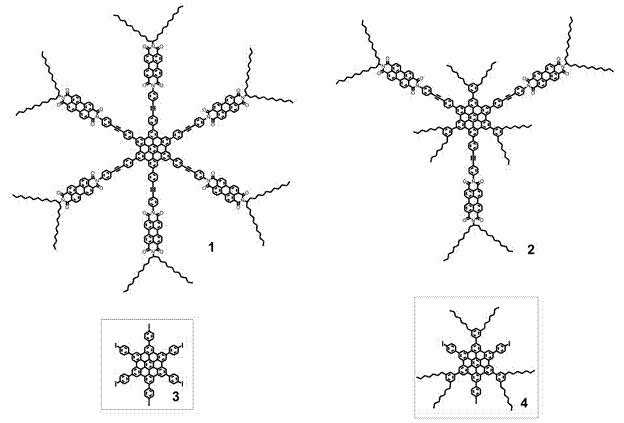Reports: G10
47677-G10 A New Type of Discotic Liquid Crystals for Organic Solar Cells
Our goal of the work supported by the PRF grant was to create a new type of multichromatic liquid crystals for organic solar cells. The motivation was to develop a reproducible, scalable way to make bulk heterojunctions, simultaneously optimizing charge separation and the subsequent charge collection in organic solar cells. The proposed work contained synthesis of the liquid-crystal-forming compounds (mesogens) and the characterization of the solar cells. In the two-year funding period, we have achieved our initial goal of synthesizing the mesogens, and are currently modifying the mesogens and characterizing their phase behaviors. A part of the funded work has led to a manuscript submitted to Angewante Chemie for publication, and the continuing work will likely lead to more publications.
The greatest achievement so far in the funded work is that we have overcome the challenge caused by the poor solubility of the chemical intermediates that had been underestimated in our original proposal. The synthesis of our initial target 1 requires a previously reported intermediate 3, which was known to have poor solubility. Despite reactivity of 3 reported in literature, in our work we found that it was not sufficiently reactive for the reactions we had planned for making 1.
To circumvent this difficulty without compromising our designing principle for the mesogens, we changed our target to 2, and have developed a more soluble and thus more reactive intermediate 4 by adding solubilizing flexible chains to 3. Its large solubility has enabled us to carry out subsequent reactions to obtain mesogen 2. Our preliminary studies have shown that 2 indeed forms liquid crystalline phases. Currently we are characterizing the packing geometry of mesogen 2 in the liquid crystalline phases and studying the phase transition behaviors of various derivatives.
Our
novel strategy to make intermediate 4
meanwhile has led to a general route to hexa-peri-hexabenzocoronene (HBC) with 3-fold symmetry (structure 5, R1![]() R2), which
by themselves are an interesting class of liquid-crystal-forming organic
semiconductors. In addition, since 5
is closely related to our current target 2,
studying 5 can provide us with
insight regarding the assembly properties and phase behavior (such as symmetry,
transition temperature, etc) of 2.
Therefore we diverted part of our effort to study derivatives of 5. A remarkable discovery in our work
is that 5 can form columnar liquid
crystalline phases at room temperature when R1= C10H21
and R2= C20H41
as a result of the symmetry, which is dramatically different from the behavior
of its 6-fold counterparts with R1= R2 = C20H41
or C10H21. Below is shown an optical image of a thin
film of 5 (R1= C10H21,
R2= C20H41)
observed between two crossed polarizers (scale bar 50 micron). Birefringent
fan-like texture characteristic of columnar phases is observed. This discovery
is exciting to us because it demonstrates the possibility of making the liquid
crystalline phases at ambient temperature for mesogens 2, potentially making our future solar cells capable of
self-healing as a result of the low viscosity of liquid crystalline phases at
ambient temperature. This work was submitted to Angewante
Chemie for publication.
R2), which
by themselves are an interesting class of liquid-crystal-forming organic
semiconductors. In addition, since 5
is closely related to our current target 2,
studying 5 can provide us with
insight regarding the assembly properties and phase behavior (such as symmetry,
transition temperature, etc) of 2.
Therefore we diverted part of our effort to study derivatives of 5. A remarkable discovery in our work
is that 5 can form columnar liquid
crystalline phases at room temperature when R1= C10H21
and R2= C20H41
as a result of the symmetry, which is dramatically different from the behavior
of its 6-fold counterparts with R1= R2 = C20H41
or C10H21. Below is shown an optical image of a thin
film of 5 (R1= C10H21,
R2= C20H41)
observed between two crossed polarizers (scale bar 50 micron). Birefringent
fan-like texture characteristic of columnar phases is observed. This discovery
is exciting to us because it demonstrates the possibility of making the liquid
crystalline phases at ambient temperature for mesogens 2, potentially making our future solar cells capable of
self-healing as a result of the low viscosity of liquid crystalline phases at
ambient temperature. This work was submitted to Angewante
Chemie for publication.






